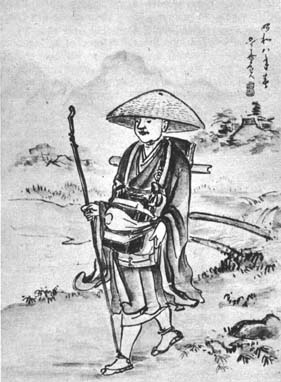In the early Ninth century the renowned Chinese master of both Zen and Huayen, Guifeng Zongmi, spoke of five styles of Zen. In the Twentieth century the Japanese Zen master Haku’un Yasutani adapted this list to express his own observations about the various ways people engage Zen. That adaptation of Guifeng’s list is captured for us in Philip Kapleau’s Three Pillars of Zen. Yasutani took Guifeng’s lifelong attempt at reconciling the indigenous wisdoms of China, particularly Confucianism with Buddhism to that newer Twentieth century concern of Zen’s encounters with the world’s religions. Worth a visit. I’ve played a little with it, as well. One version of my reflections is offered at my Introduction to Zen Koans.
And. I’ve been thinking a lot about the Zen encounter with Christianity in particular. Here and here, for example) With that I’ve found myself returning to that list and considering what’s what with Zen. Why is it that people who are not Buddhist do indeed seem to find value in Zen and its disciplines. And, more, sometimes. Sometimes they seem able to see into the great heart of the matter just as clearly, on occasion it appears, even more clearly than among Buddhists.
This list is a list and with that arbitrary. Also there’s an almost irresistible urge to put them into some sort of hierarchy, lowest to highest. I’ve found it important to try and resist that urge. With that our list.
Bompu Zen, usually rendered as “ordinary Zen.” Maybe its better to call this “secular Zen.” This is where we encounter Zen the way many people engage yoga or Chinese movement practices – as a form of mental exercise. Perhaps Jon Kabat-Zinn’s MBSR could be seen as an example of “bompu Buddhism.” Over the many years I’ve encountered any number of people who have come to our Zen sangha because they wanted to lower their blood pressure or something similar. Yasutani warned it is easy in this style to remain trapped in a dualistic view, where there is something to be fixed, which falls well short of what one might find within Zen. I admit I’ve tended to be judgmental of those who start Zen for this reason. And. Here’s the deal, people can practice for their health and as the practice does the practice things happen.
Shojo Zen, rendered “self-centered Zen” is similar to Bompu. And like all lists, as I noted, somewhat arbitrary. But, personally I’d put the phenomenon of Zen’s encounter with psychology here. There’s a growing literature of the value of Zen’s practices to psychological concerns. And, I’ve noted psychological corrections to some aspects of Zen, creating some vital possibilities. I think of the work of Joko Beck as well as her successors Ezra Bayda and perhaps most importantly Barry Magid. The focus here is on oneself. And, the shadow is for it all to remain private, and centered on one’s own concerns. That said, some of the wisest teachers I’ve encountered lead from this direction. For instance I consider both Bayda and Magid offering deeply profound and important perspectives on the great Way.
Third is Gedo Zen, or “Zen outside the Way.” This is the adaptation of Zen by other spiritual traditions. And it is what generated my return to this list. Ruben Habito’s Living Zen, Loving God provides a small peek into what this sometimes looks like within the Christian adaptation of Zen & its practices. There are many people from the Buddhist side who assert that Christianity’s essential dualism makes any legitimate adaptation of Zen impossible. And on the other side the list of those asserting the adaptation of Zen to Christian concerns is inviting the cloven hoof into the church. For each any Christian Zen is like describing a bumble bee. Physiologically it should not be able to fly. And, yet, it does.
So, I look around and several of the Zen teachers I respect most profoundly are among these Christian Zen masters. Here’s one. Here’s another.
Of course the list doesn’t end there. In fact within “normative” Zen there are two rather distinct variations.
Godo Zen is usually designated “Buddhist Zen.” Here we find a type of Zen focused on the saving of all beings, and the striving for awakening. The danger is what in Zen is sometimes called “striving mind,” a desire that is in itself inherently dualistic. Curricular koan Zen is a classic example. Both Rinzai and my own line derived through the Soto master Daiun Sogaku Harada fall into this form. I hope its not too egotistic to suggest my recent Introduction to Zen Koans might be a good introduction to this approach.
And, last, Saijojo Zen, “Perfected Zen.” Here is the Zen where zazen does zazen, where striving and rest are not two. Of course, neither are they one, at least from the perspective of the realization of Saijojo. The shadow here is falling into a form of quietism where one spiritually sleeps away their life. This is the Zen of the Soto school. I think there is no better book describing this way than that first “Western” Zen Buddhist classic, Zen Mind, Beginner’s Mind.
Yasutani points out how these last two, Godo and Saijojo complement and challenge each other. In case you’re interested here’s one reading list that might be helpful.
And, I’m realizing how that’s true for all the other forms of Zen that manifest, as well. All of them.
The project is awakening. The method is found in the meditative disciplines of shikantaza and koan introspection. Add in regular sitting. Retreats. And, oh yes, competent guidance. Mix well.
And let it come to the great boil…
Out of this we find who we are, what the world is, and what is to be done.













